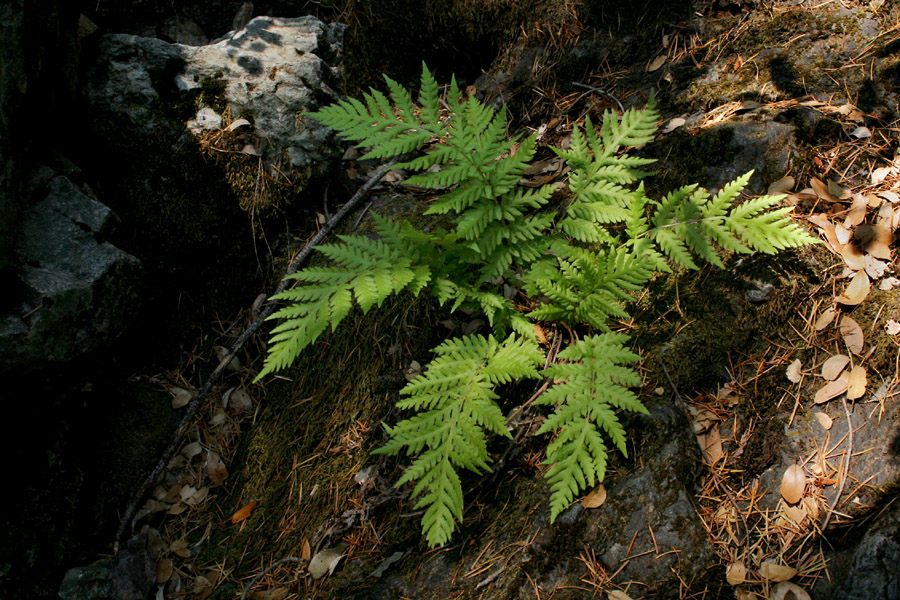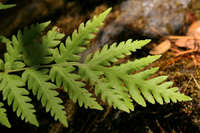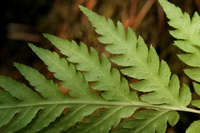|
|
|
|
Family: Blechnaceae
giant chainfern
[Woodwardia chamissoi Brack.] |
Stems forming a stout caudex covered with petiole bases, suberect; scales light brown, many, lanceolate-attenuate. Leaves monomorphic, evergreen, numerous in vaselike cluster, 40-170 cm. Petiole straw-colored, sometimes reddish at base; base thickened, with densely set orange scales. Blade pale green, elliptic-lanceolate, 25-100 cm, scaly-glandular upon emergence but soon glabrate. Pinnae not articulate to rachis, in 8-24 pairs, narrowly deltate to lanceolate, pinnatifid; proximal to middle pinnae 12-42 × 2.5-8 cm. Veins anastomosing to form single row of areoles, then free to margin. Sori short and broad, mostly curved and confined to costular areoles, deeply sunken into blades. Indusia cartilaginous and vaulted; cells thickened, retaining configuration after dehiscence of sporangia. 2 n = 68. Redwood forests, mixed conifer forests, and mixed conifer-hardwood forests, always where moisture is present, such as stream banks or springs; 0-1000 m; B.C.; Ariz., Calif., Nev., Oreg., Wash.; Mexico in n Baja California. Woodwardia fimbriata is confined primarily to the California floristic province; it is disjunct and local elsewhere.
RHIZOMES: stout, forming a short ascending caudex, usually unbranched, the scales 10-30 mm long, lanceolate, acuminate at the the tip, monomorphic, light brown, somewhat shiny, the margins entire or nearly so. LEAVES: densely clustered at the rhizome apex, 40-170 cm long (Fig. 3). PETIOLES: straw-colored, brown at the base, glabrous distally, thickened and densely scaly at the persistent base, the scales 5-25 mm long, lanceolate, orangish brown. RACHISES: similar to petioles, straw colored to green, glabrous. BLADES: 15-45 cm wide, broadly elliptic-lanceolate, pinnatepinnatifid proximally grading to pinnatifid distally, with usually numerous lateral pinnae, the basal few pairs of pinnae somewhat reduced. PINNAE: mostly 8-40 cm long, 2.5-8.0 mm wide, with numerous deep lobes (Fig. 2). LOBES: with minute glandular trichomes, especially adaxially, when young, glabrous at maturity, the margins mostly minutely serrulate. SORI: sunken into relatively deep pits in the blade surface, narrowly oblong. INDUSIA: thick-papery, persistent, glabrous. SPORES: 57-68 μm long, the surface rugose, dark brown. 2n = 68. NOTES: Mesic canyon bottoms, usually among boulders along streams: Gila, Graham, Maricopa, Pima, Santa Cruz cos. (Fig. 1); 1550-2200 m (5000-7000 ft). WA, OR, CA, NV, AZ, sw Can., nw Mex. Authors were unable to substantiate Morton’s (in Kearney and Peebles 1960) report of this species from Apache and Cochise Counties. REFERENCES: Yatskievych, G. and M.D. Windham. 2008. Vascular Plants of Arizona: Blechnaceae. CANOTIA 4 (2): 35-37. |





